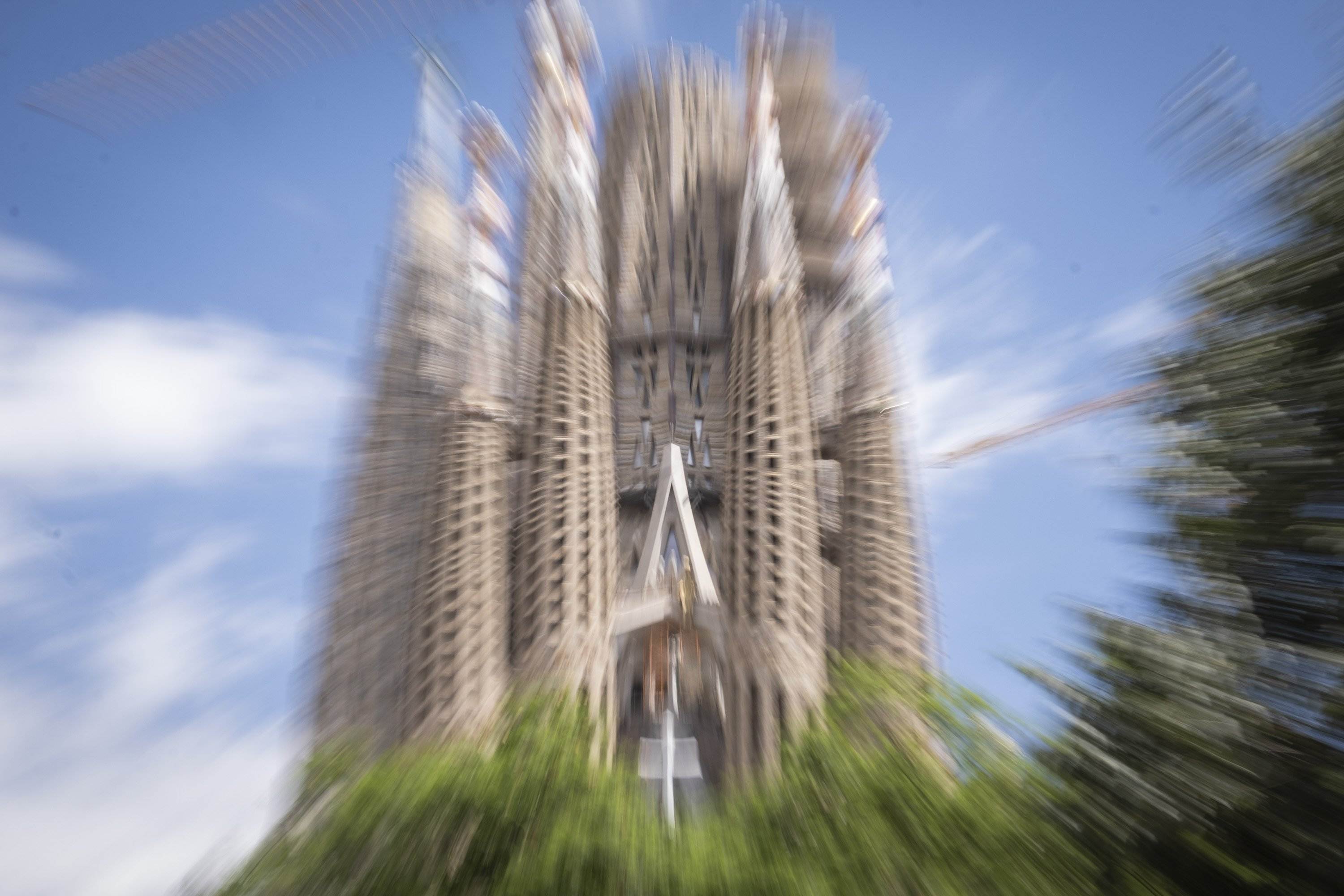The temple of the Sagrada Família, the world-renowned master work of Antoni Gaudí, has been under construction for 141 years, and even if for many Barcelonans the works seem eternal, its completion is just a matter of years away. Although the construction board prefers not to give any fixed date for the completion of the works, having already had to renounce the earlier target of 2026 after Covid-19 reduced income from tourism, that situation has now turned around: tourist visits in 2023 are set to equal the total for 2019, and it can thus be predicted that the works should not extend much beyond the end of the decade.
In fact, despite the stoppage during the pandemic, in the years since, construction has risen to cruising speed, with major milestones being completed year after year, especially with regard to the towers, which are the most visual elements of the construction. The Barcelona skyline is changing at a dizzying pace, with the skyward rise of the Tower of Jesus Christ, which, when it is finished in 2026, will make the Sagrada Família the tallest structure in Barcelona apart from the Collserola communications tower. But already, residents and visitors have seen the openings of the Tower of the Virgin Mary in 2021, those of the Evangelists Mark and Luke in 2022 and those of the other two Evangelists, Matthew and John, this year.
What has been done in 2023?
The temple's construction board itself reports annually on the progress of work and has recently reviewed the progress for 2023, with a series of building tasks that range from the spectacularly visible to those that are not so obvious to the public but are also important for the completion of the work: here is the full list of construction achievements this year, according to the explanations given by the chief architect, Josep Faulí, on September 19th:
- Crossing Room. At about 60 metres above ground level, this space is on top of the main nave, and directly above the crossing, that is, the point where the nave and the perpendicular transept cross. In turn, above the Crossing Room, the Tower of Jesus Christ stretches upwards. The interior of the space has been completed, and a temporary access installed.
- Towers of the Evangelists. This September, the towers of the Evangelists Matthew and John were completed, and during October the scaffolding around them will be dismantled, allowing them to be seen in their entirety from the street. A blessing ceremony for these two towers will take place on November 12th, the day on which the illumination of all four towers dedicated to the evangelists - Matthew, Mark, Luke and John - will be officially switched on and daily lighting will continue until after the Christmas period. In the future, the four towers will form a halo around the Tower of Jesus Christ.
- Tower of Jesus Christ. Construction of this, the temple's tallest tower, has been completed up to the ninth level of the twelve which will form its trunk, with the pinnacle to be be built on top of that. Currently, the tower is 131 metres high, four metres less than the towers of the evangelists and still 23 metres short of the twin towers of the Vila Olímpica, the tallest buildings in Barcelona at 154 metres - with the tallest construction of any kind being the Torre de Collserola, the telecommunications tower on the skyline at the back of the city, which is 267 metres tall.
- Restoration of the Towers of the Nativity Facade. The Jude Thaddeus and Matthias towers have been restored and work is being done on the Barnabas and Simon towers. Cleaning and replacement of elements have been carried out although, according to the construction board itself, the pinnacles were in good condition considering that a hundred years have gone by since their construction.
- Chapel of the Assumption: Begun in 2022, this chapel is located next to the apse on Carrer Provença. At the moment, the foundations have been completed along with sections of the cloister and the basement, that is located eleven metres below ground level.
- Basements: Located five metres below ground, there is a floor area of 3,500 square metres empty, which will be used as a museum and workshops.
- Baptistery: Located on the corner of Carrers Sardenya and Mallorca, to the right of the Glory facade, work is already underway on the foundations and the basement slab.
- Roofs of the side naves: Work has resumed on the side roofs, which will have windows allowing natural light to enter the nave skylights.
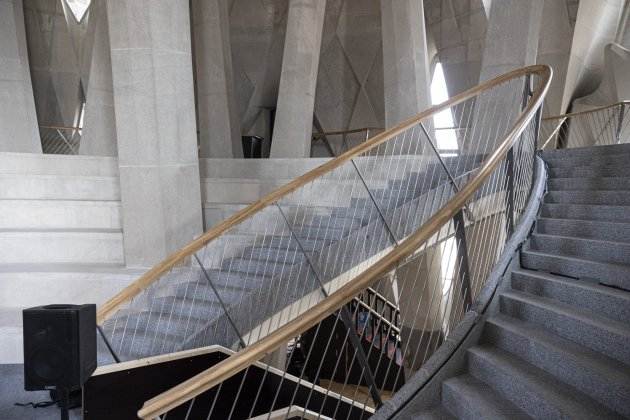
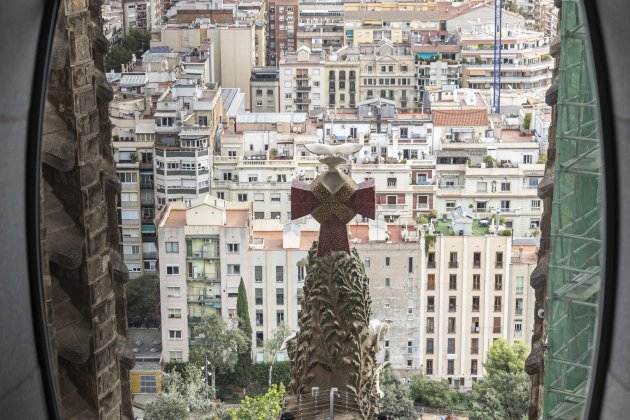
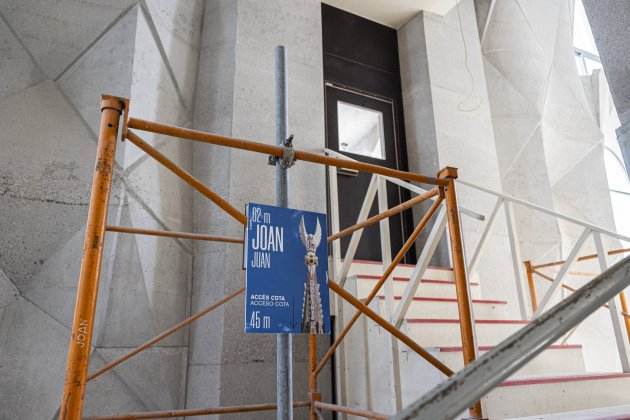
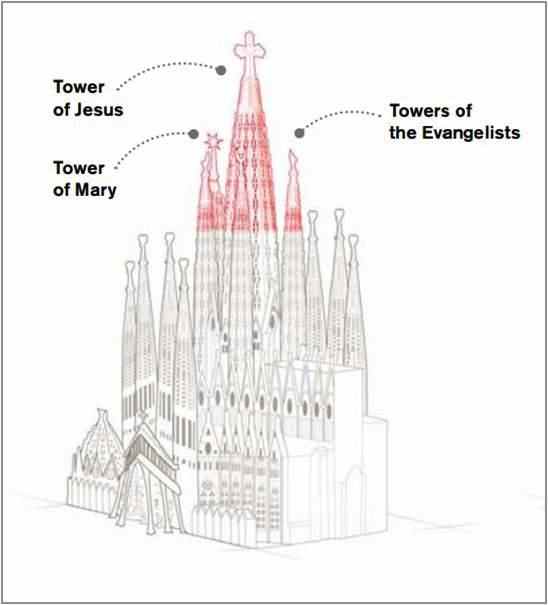
What is still to be built?
Despite the progress, both the high profile achievements altering the city skyline, and the less visible, such as the construction carried out at basement levels, the fact is that there is still a lot of work remaining, so that even if the crowning of the Tower of Jesus Christ is planned for 2026, the full completion of the Sagrada Família will take several more years, at least until the end of this decade or perhaps even a little beyond. These are the main tasks pending:
- Crossing Room: In 2025, it is expected that the lighting elements will be installed in the ceiling as well as access via walkways, which will allow the vaults of the crossing to be seen.
- Tower of Jesus Christ: With the target date for its completion set at 2026 - the centenary of the death of Antoni Gaudí - the Tower of Jesus Christ has three further levels of its trunk remaining to be built, and that point on now on new levels will have to be built with an outer scaffolding, whereas up to the ninth level, the technique involved inner scaffolding. Once the trunk is finished, the entire pinnacle of the tower will still need to be built. It will reach a further 17 metres higher and will be crowned by a colossal four-armed cross that will be accessible via a spiral staircase with its interior that will be open to visitors. Next year, in 2024, the prototype of this cross will be put on display. Construction of the accesses and elevator is also pending. The entire tower with its crowning cross will be 172.5 metres tall, which means that it still has to rise more than 40 metres above its current height, and this will mark a radical change in Barcelona's urban silhouette. To give an idea, Rio de Janeiro's well-known Christ the Redeemer statue, which is 38 metres high, could fit in the height yet to be added to the Tower of Jesus Christ.
- Restoration of the Towers of the Nativity facade: The restoration of the towers dedicated to Barnabas and Simon is pending completion.
- Chapel of the Assumption: The projection is to complete this chapel, which will be crowned by a 30-metre-high dome, in 2025. When it is completed, it will have four cloisters, whose constuction has already begun.
- Roofs: Work is currently underway on the roofs of the side naves, but the central roof is still pending.
- Sacristy: This will be one of the last parts to be built, located on the corner of Carrers Provença and Marina. The reason for leaving this part for the end is logistical, as it is currently used as an entrance and for construction material storage.
- Chapel of Penitence: To be located on the corner of Carrer Marina and Mallorca, with construction not yet started.
- Metro access: As part of the work being done on the underground levels, and at the request of the Barcelona city council, there is space reserved for a possible direct connection to the Metro under the stairs of the Nativity facade. However, according to the Construction Board, whether access is finally made depends on studies required to confirm its feasibility. In fact, it is work that could be left until after the official completion date of the temple.
- The Glory Façade: This is the most visually important part that is still pending, since it will be the main facade, the one facing Carrer Mallorca, and will be crowned by four towers that will complete the twelve dedicated to the apostles - with the others in the facades of the Nativity and the Passion. For the vertical part of the façade construction, which is within the boundaries of the site, it is only a matter of time before work begins, but the most complicated aspect is that of the access. And that deserves a separate treatment.
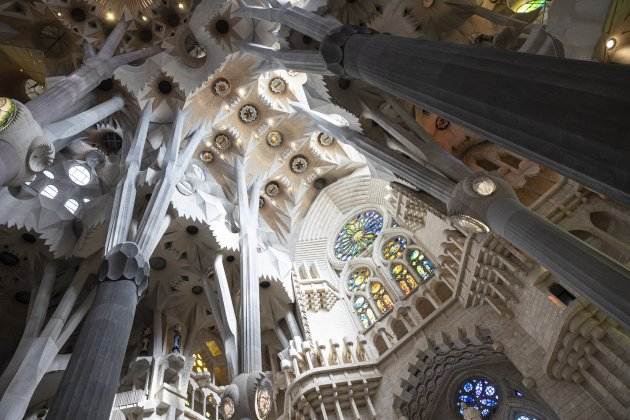
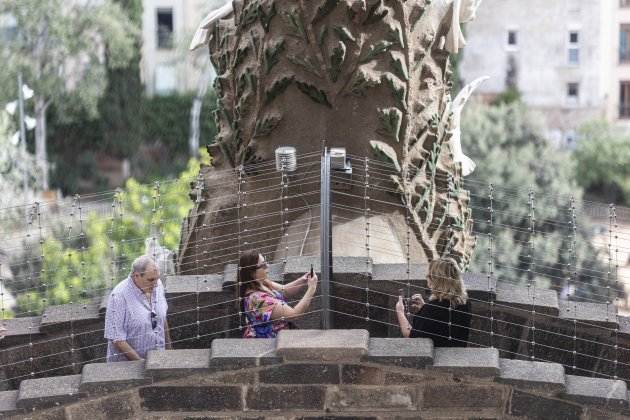
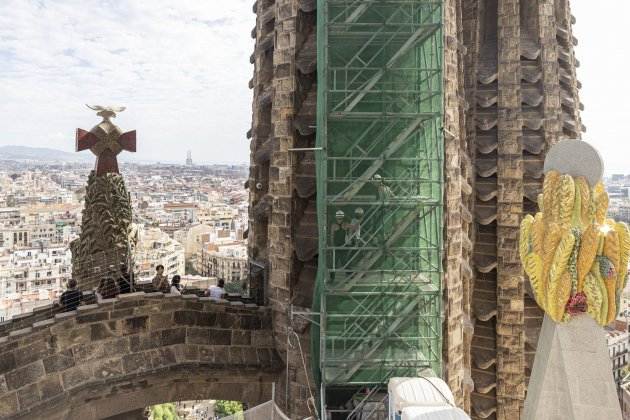
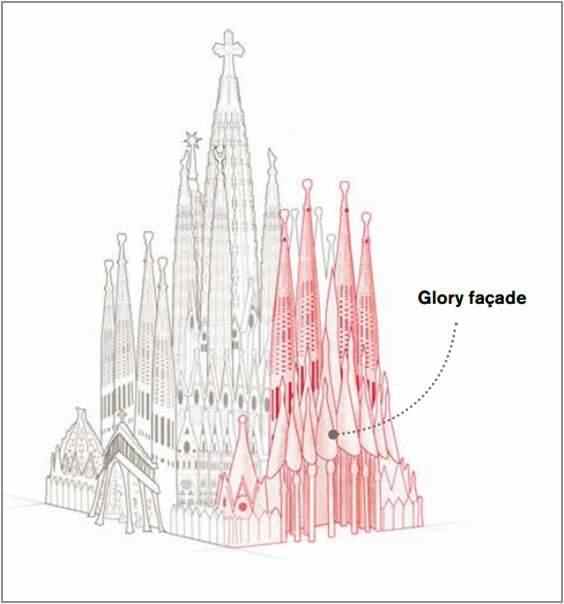
The grand entry staircase, the most critical issue
If there is one point that could block the completion of the Sagrada Família in the medium term, it is the access via Carrer Mallorca to what is planned to be the future main entrance to the temple through the Glory façade. The unevenness of the site means that the doorway on this façade is several metres above street level and the construction board plans to resolve this with a grand staircase that would cross Carrer Mallorca. In fact, the temple maintains that this feature was the design intention of Antoni Gaudí himself, who envisioned the construction of an overpass over the street.
The issue is that this approach requires the demolition of the buildings that are directly opposite, or at least one of them, and this is opposed by the residents, who demand a solution to the access that will not affect them and give them the security that they will not lose their homes. Even though the possibility of building new replacement homes on nearby sites is on the table, the fact is that for years there has been a struggle between the construction board, which maintains the plan for the entry staircase, and the local residents, represented by the Sagrada Família Residents Association and, especially, the Association of those Affected by the Construction of the Sagrada Família.
With the intention of reaching a consensual solution, a first tripartite meeting was held at the beginning of 2020, with representatives of the temple, the residents and the Barcelona city council, but the onset of the pandemic froze this commitment to dialogue, and it has not been resumed thus far. At present, the situation remains stuck despite the parties having shown, in recent days, their intention to work on a solution. On September 19th this year, as part of the presentation of the new developments at the temple, the director general of the Sagrada Familia construction board, Xavier Martínez, affirmed that the board was "available to the city council to meet and talk about the matter", pointing out, of course, what his starting point would be: "Antoni Gaudí designed the staircase in his day and it is a part that we will not give up".
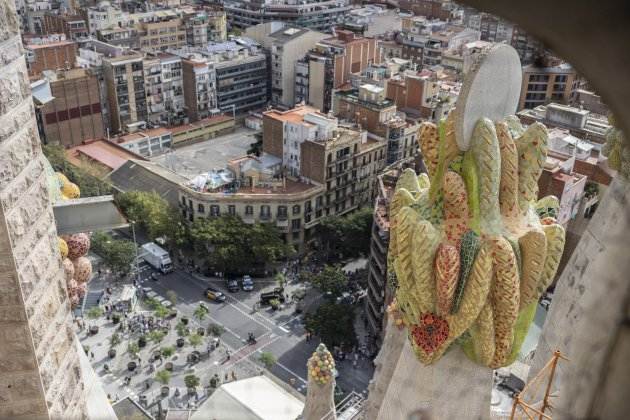
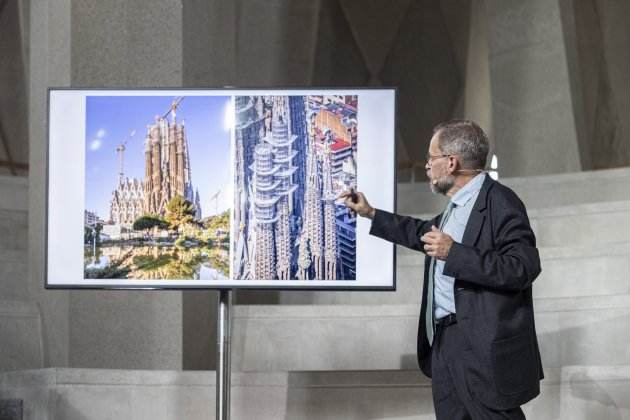
On the residents' side, the president of the Association of those Affected by the Construction of the Sagrada Família, Salvador Barroso, has indicated in statements to ElNacional.cat that the neighbours also wanted to resume dialogue and urged mayor Collboni to call the parties together: "We hope that the city council also will call us to meet", warned Barroso, who argues for a solution that will avoid the demolition of current homes.
With these positions, the ball is now in the court of the city council to announce meetings. For now, however, the mayor of Barcelona, Jaume Collboni, has limited himself to affirming, when requested by this newspaper on the occasion of the first hundred days of his mandate, that he will promote dialogue: "I can guarantee that there will be dialogue with the board and obviously with the residents", he said. Now all they need to know is when that will begin.

